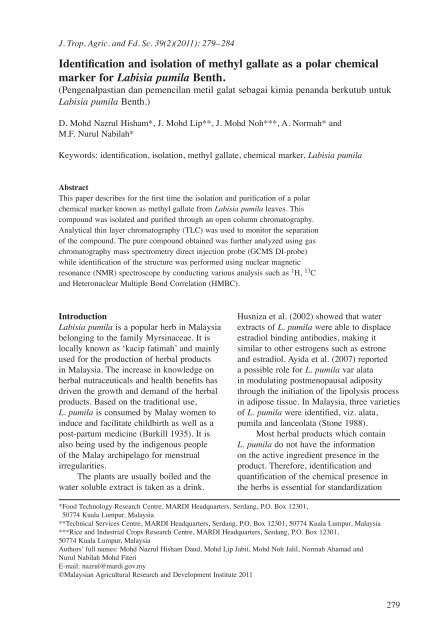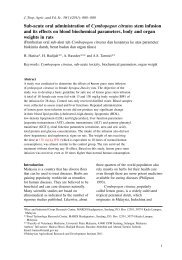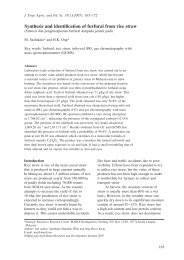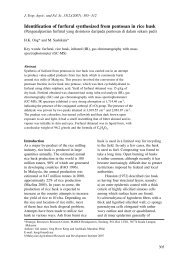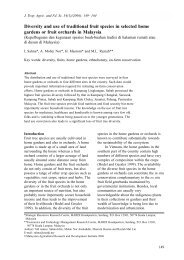Identification and isolation of methyl gallate as a polar ... - Mardi
Identification and isolation of methyl gallate as a polar ... - Mardi
Identification and isolation of methyl gallate as a polar ... - Mardi
Create successful ePaper yourself
Turn your PDF publications into a flip-book with our unique Google optimized e-Paper software.
J. Trop. Agric. <strong>and</strong> Fd. D. Sc. Mohd 39(2)(2011): Nazrul Hisham, 279– J. 284 Mohd Lip, J. Mohd Noh, A. Normah <strong>and</strong> M.F. Nurul Nabilah<br />
<strong>Identification</strong> <strong>and</strong> <strong>isolation</strong> <strong>of</strong> <strong>methyl</strong> <strong>gallate</strong> <strong>as</strong> a <strong>polar</strong> chemical<br />
marker for Labisia pumila Benth.<br />
(Pengenalp<strong>as</strong>tian dan pemencilan metil galat sebagai kimia pen<strong>and</strong>a berkutub untuk<br />
Labisia pumila Benth.)<br />
D. Mohd Nazrul Hisham*, J. Mohd Lip**, J. Mohd Noh***, A. Normah* <strong>and</strong><br />
M.F. Nurul Nabilah*<br />
Keywords: identification, <strong>isolation</strong>, <strong>methyl</strong> <strong>gallate</strong>, chemical marker, Labisia pumila<br />
Abstract<br />
This paper describes for the first time the <strong>isolation</strong> <strong>and</strong> purification <strong>of</strong> a <strong>polar</strong><br />
chemical marker known <strong>as</strong> <strong>methyl</strong> <strong>gallate</strong> from Labisia pumila leaves. This<br />
compound w<strong>as</strong> isolated <strong>and</strong> purified through an open column chromatography.<br />
Analytical thin layer chromatography (TLC) w<strong>as</strong> used to monitor the separation<br />
<strong>of</strong> the compound. The pure compound obtained w<strong>as</strong> further analyzed using g<strong>as</strong><br />
chromatography m<strong>as</strong>s spectrometry direct injection probe (GCMS DI-probe)<br />
while identification <strong>of</strong> the structure w<strong>as</strong> performed using nuclear magnetic<br />
resonance (NMR) spectroscope by conducting various analysis such <strong>as</strong> 1 H, 13 C<br />
<strong>and</strong> Heteronuclear Multiple Bond Correlation (HMBC).<br />
Introduction<br />
Labisia pumila is a popular herb in Malaysia<br />
belonging to the family Myrsinaceae. It is<br />
locally known <strong>as</strong> ‘kacip fatimah’ <strong>and</strong> mainly<br />
used for the production <strong>of</strong> herbal products<br />
in Malaysia. The incre<strong>as</strong>e in knowledge on<br />
herbal nutraceuticals <strong>and</strong> health benefits h<strong>as</strong><br />
driven the growth <strong>and</strong> dem<strong>and</strong> <strong>of</strong> the herbal<br />
products. B<strong>as</strong>ed on the traditional use,<br />
L. pumila is consumed by Malay women to<br />
induce <strong>and</strong> facilitate childbirth <strong>as</strong> well <strong>as</strong> a<br />
post-partum medicine (Burkill 1935). It is<br />
also being used by the indigenous people<br />
<strong>of</strong> the Malay archipelago for menstrual<br />
irregularities.<br />
The plants are usually boiled <strong>and</strong> the<br />
water soluble extract is taken <strong>as</strong> a drink.<br />
Husniza et al. (2002) showed that water<br />
extracts <strong>of</strong> L. pumila were able to displace<br />
estradiol binding antibodies, making it<br />
similar to other estrogens such <strong>as</strong> estrone<br />
<strong>and</strong> estradiol. Ayida et al. (2007) reported<br />
a possible role for L. pumila var alata<br />
in modulating postmenopausal adiposity<br />
through the initiation <strong>of</strong> the lipolysis process<br />
in adipose tissue. In Malaysia, three varieties<br />
<strong>of</strong> L. pumila were identified, viz. alata,<br />
pumila <strong>and</strong> lanceolata (Stone 1988).<br />
Most herbal products which contain<br />
L. pumila do not have the information<br />
on the active ingredient presence in the<br />
product. Therefore, identification <strong>and</strong><br />
quantification <strong>of</strong> the chemical presence in<br />
the herbs is essential for st<strong>and</strong>ardization<br />
*Food Technology Research Centre, MARDI Headquarters, Serdang, P.O. Box 12301,<br />
50774 Kuala Lumpur, Malaysia<br />
**Technical Services Centre, MARDI Headquarters, Serdang, P.O. Box 12301, 50774 Kuala Lumpur, Malaysia<br />
***Rice <strong>and</strong> Industrial Crops Research Centre, MARDI Headquarters, Serdang, P.O. Box 12301,<br />
50774 Kuala Lumpur, Malaysia<br />
Authors’ full names: Mohd Nazrul Hisham Daud, Mohd Lip Jabit, Mohd Noh Jalil, Normah Ahamad <strong>and</strong><br />
Nurul Nabilah Mohd Fiteri<br />
E-mail: nazrul@mardi.gov.my<br />
©Malaysian Agricultural Research <strong>and</strong> Development Institute 2011<br />
279
Polar chemical marker for Labisia pumila<br />
<strong>and</strong> verification purposes. B<strong>as</strong>ed on<br />
European Medicines Agency (EMEA),<br />
st<strong>and</strong>ardization <strong>of</strong> herbal product is defined<br />
<strong>as</strong> herbal preparation containing a substance<br />
or group <strong>of</strong> substances with known<br />
therapeutic activity which can be used to<br />
st<strong>and</strong>ardise a biological effect or used <strong>as</strong><br />
marker compounds (Zhari <strong>and</strong> Jamshed<br />
2010). Therefore, identification <strong>of</strong> an active<br />
chemical marker from L. pumila extract is<br />
essential for st<strong>and</strong>ardization <strong>of</strong> L. pumila<br />
b<strong>as</strong>ed products.<br />
The objective <strong>of</strong> this study w<strong>as</strong><br />
to isolate a potential chemical marker<br />
for L. pumila which can be used for<br />
st<strong>and</strong>ardization <strong>and</strong> verification <strong>of</strong> the herbs.<br />
In this study, <strong>methyl</strong> <strong>gallate</strong> w<strong>as</strong> isolated<br />
from L. pumila leaves <strong>and</strong> its spectroscopy<br />
data were analysed to prove the identity <strong>of</strong><br />
the compound. In a previous study, <strong>methyl</strong><br />
<strong>gallate</strong> w<strong>as</strong> demonstrated to have high<br />
antioxidant activity <strong>and</strong> cytotoxic towards<br />
cancer cell lines (Yong et al. 2005). Various<br />
types <strong>of</strong> bioactivities were also reported<br />
such <strong>as</strong> antimicrobial, sucr<strong>as</strong>e inhibitor,<br />
collagen<strong>as</strong>e inhibitor <strong>and</strong> used <strong>as</strong> treatment<br />
for enteritis (Chaubal et al. 2005).<br />
Materials <strong>and</strong> methods<br />
Sample preparation<br />
Three kg <strong>of</strong> fresh L. pumila leaves were<br />
collected from MARDI Kluang station <strong>and</strong><br />
ground to 2.0 mm particle size.<br />
Preparation <strong>of</strong> methanol extract<br />
The fresh L. pumila leaves were ground to<br />
2.0 mm particle size <strong>and</strong> soaked in 100%<br />
methanol (MeOH, which is close to aqueous<br />
extract) for 4 days at room temperature<br />
after which the extract w<strong>as</strong> decanted (Mohd<br />
Nazrul Hisham et al. 2010). The plant<br />
material w<strong>as</strong> replenished with fresh MeOH<br />
<strong>and</strong> the same extraction procedure repeated<br />
twice. The extracts collected from each<br />
soaking were pooled <strong>and</strong> concentrated to<br />
dryness using a rotary evaporator to obtain<br />
the crude extract.<br />
280<br />
Isolation <strong>of</strong> <strong>methyl</strong> <strong>gallate</strong><br />
The crude methanol extract <strong>of</strong> L. pumila<br />
w<strong>as</strong> then resuspended in distilled water<br />
<strong>and</strong> solvent partitioned with hexane,<br />
dichloromethane (CH 2 Cl 2 ), ethyl acetate<br />
(EtOAc) <strong>and</strong> butanol (BuOH) (Yong et al.<br />
2005). Ethyl acetate fraction (10 g) w<strong>as</strong><br />
first subjected to normal ph<strong>as</strong>e column<br />
chromatography (CC). Elution started with<br />
100% chlor<strong>of</strong>orm (CHCl 3 ) followed by<br />
mixtures <strong>of</strong> CHCl 3 :MeOH <strong>of</strong> incre<strong>as</strong>ing<br />
<strong>polar</strong>ity to yield a total <strong>of</strong> ten fractions.<br />
B<strong>as</strong>ed on similar TLC patterns,<br />
fractions 3 to 5 (4 g) were recombined <strong>and</strong><br />
subjected to normal ph<strong>as</strong>e open column<br />
chromatography using 100% chlor<strong>of</strong>orm<br />
(CHCl 3 ) <strong>as</strong> mobile ph<strong>as</strong>e, followed by<br />
mixtures <strong>of</strong> CHCl 3 :MeOH <strong>of</strong> incre<strong>as</strong>ing<br />
<strong>polar</strong>ity. Ten fractions were collected, <strong>and</strong><br />
b<strong>as</strong>ed on similar TLC patterns, fractions<br />
7 to 10 (2.5g) were recombined <strong>and</strong><br />
subjected to open mini column normal ph<strong>as</strong>e<br />
chromatography using 100% chlor<strong>of</strong>orm<br />
(CHCl 3 ) <strong>as</strong> mobile ph<strong>as</strong>e, followed by<br />
mixtures <strong>of</strong> CHCl 3 :MeOH <strong>of</strong> incre<strong>as</strong>ing<br />
<strong>polar</strong>ity to obtain 20 mg <strong>of</strong> white crystals.<br />
M<strong>as</strong>s analysis<br />
M<strong>as</strong>s spectra were recorded on a Shimadzu<br />
GC-17A g<strong>as</strong> chromatography m<strong>as</strong>s<br />
spectrometer (GCMS). The GCMS w<strong>as</strong><br />
equipped with a direct injection probe<br />
(DI-probe) to analyse pure samples without<br />
p<strong>as</strong>sing through the capillary column. The<br />
pure isolated compound (in white crystal<br />
form) w<strong>as</strong> subjected to m<strong>as</strong>s spectroscopy<br />
analysis <strong>and</strong> the m<strong>as</strong>s spectrum elucidated to<br />
support the NMR analysis for determination<br />
<strong>of</strong> the chemical structure.<br />
Nuclear Magnetic Resonance (NMR)<br />
analysis<br />
The pure white crystals were placed on<br />
top <strong>of</strong> the probe <strong>and</strong> subjected to 1 H, 13 C<br />
NMR <strong>and</strong> two dimensional analyses such<br />
<strong>as</strong> Heteronuclear Multiple Bond Correlation<br />
(HMBC). The different spectrum <strong>of</strong> the<br />
isolated compound were recorded on a<br />
Varian Unity Inova (500 MHz) equipped
with pulsed field gradients (PFG), using<br />
an indirect detection probe. Deuterated<br />
methanol w<strong>as</strong> used <strong>and</strong> chemical shifts (δ<br />
<strong>and</strong> δC) were given in parts per million<br />
(ppm).<br />
Results <strong>and</strong> discussion<br />
Characterization <strong>of</strong> compound isolated <strong>as</strong><br />
<strong>methyl</strong> <strong>gallate</strong><br />
The compound isolated from repeated<br />
normal ph<strong>as</strong>e column chromatography<br />
<strong>as</strong> white crystals were subjected to m<strong>as</strong>s<br />
analysis using the GCMS DI-probe<br />
<strong>and</strong> NMR spectrometric analysis for<br />
confirmation <strong>of</strong> the chemical structure.<br />
The 1 H NMR spectrum <strong>of</strong> the isolated<br />
compound (Figure 1) demonstrated a<br />
typical signal for aromatic protons at δ 7.0.<br />
H-2,<br />
H-6<br />
Figure 1. 1 H NMR spectrum <strong>of</strong> <strong>methyl</strong> <strong>gallate</strong><br />
C=O<br />
C-3,C-5<br />
D. Mohd Nazrul Hisham, J. Mohd Lip, J. Mohd Noh, A. Normah <strong>and</strong> M.F. Nurul Nabilah<br />
C-4 C-1<br />
C-2,C-6<br />
0-CH 3<br />
Figure 2. 13 C NMR spectrum <strong>of</strong> <strong>methyl</strong> <strong>gallate</strong><br />
B<strong>as</strong>ed on the integration <strong>of</strong> the signals,<br />
there are two aromatic protons (H-2<br />
<strong>and</strong> H-6) which are symmetrical to each<br />
other. Therefore, both protons are giving<br />
the same signal at δ H 7.0. In the higher<br />
field region, there is another signal from<br />
aliphatic methoxy protons at δ H 3.8 <strong>and</strong><br />
b<strong>as</strong>ed on the integration <strong>of</strong> the signal, the<br />
presence <strong>of</strong> these protons are in agreement<br />
with the number <strong>of</strong> protons in the methoxy<br />
substituent.<br />
The 13 C NMR spectrum <strong>of</strong> the isolated<br />
compound (Figure 2) exhibited resonances<br />
for seven types <strong>of</strong> carbons comprising a<br />
C=O signal at δc 167.9 (indicating the<br />
presence <strong>of</strong> carbonyl ester), one oxygenated<br />
aromatic carbon signal at δc 138.8 (C- 4),<br />
two symmetrical oxygenated aromatic<br />
281
Polar chemical marker for Labisia pumila<br />
carbon signals at δc 145.3 (C-3 <strong>and</strong> C-5),<br />
one quaternary aromatic carbon signal at δc<br />
120.3(C-1) <strong>and</strong> two symmetrical aromatic<br />
methine carbon signals at δc 108.9 (C-2 <strong>and</strong><br />
C-6). These signals are similar to all carbon<br />
signals from <strong>methyl</strong> <strong>gallate</strong>.<br />
Analysis <strong>of</strong> the HMBC spectra<br />
(Figure 3a-c) showed the correlation<br />
between aromatic proton signal <strong>and</strong> the<br />
carbonyl ester. The spectrum in Figure 3a<br />
indicates the 2 J correlation <strong>of</strong> methine<br />
aromatic protons signal at δ H 7.0 with two<br />
symmetrical oxygenated aromatic carbon<br />
signals at δc 145.3 (C-3 <strong>and</strong> C-5) <strong>and</strong> also<br />
with one quaternary aromatic carbon signal<br />
at δc 120.3(C-1). B<strong>as</strong>ed on HMBC spectra<br />
in Figures 3a <strong>and</strong> 3c, 3 J correlations were<br />
O-CH 3<br />
282<br />
H-2,<br />
H-6<br />
C=O<br />
C<br />
Figure 3a. HMBC correlation <strong>of</strong> symmetrical aromatic protons (H-2 <strong>and</strong> H-6)<br />
with carbonyl ester <strong>and</strong> methoxy with aromatic quaternary carbon<br />
O-CH 3<br />
C=O<br />
Figure 3b. HMBC correlation <strong>of</strong> carbonyl with methoxy<br />
observed between methine aromatic protons<br />
signal at δ H 7.0 with the carbonyl ester<br />
carbon signal at δc 167.9 <strong>and</strong> an oxygenated<br />
aromatic carbon signal at δc 138.8 (C-4).<br />
The HMBC spectra also demonstrated<br />
that the 3 J correlations between H-2 proton<br />
signal at δ H 7.0 with aromatic methine<br />
carbon signal at δc 108.9 (C-6) <strong>and</strong> H-6<br />
proton signal correlated to aromatic methine<br />
carbon signal at δc 108.9 (C-2). Similar<br />
correlations were also observed in gallic<br />
acid structure elucidation <strong>as</strong> reported by<br />
Tatsuya et al. (2008). Further analysis <strong>of</strong><br />
HMBC spectrum in Figure 3b, 3 J correlation<br />
w<strong>as</strong> observed between the methoxy proton<br />
signals at δ H 3.8 with carbonyl ester carbon<br />
signal at δc 167.9.
The m<strong>as</strong>s spectrum <strong>of</strong> the electron<br />
impact-m<strong>as</strong>s spectroscopy (EI-MS)<br />
(Figure 4) shows the molecular ion peak at<br />
m/z 184 which agrees with the molecular<br />
weight <strong>of</strong> <strong>methyl</strong> <strong>gallate</strong>. The b<strong>as</strong>e peak<br />
at m/z 153 showed the most abundant <strong>of</strong><br />
ion species which resulted from the loss<br />
<strong>of</strong> the methoxy group from the molecular<br />
ion. The presence <strong>of</strong> signal at m/z 125 is<br />
due to the loss <strong>of</strong> the carbonyl group from<br />
the b<strong>as</strong>e peak ion. Further fragmentation<br />
formed a signal at m/z 107. B<strong>as</strong>ed on the<br />
NMR data <strong>and</strong> m<strong>as</strong>s interpretation above,<br />
the compound isolated from L. pumila is<br />
ambiguously identified <strong>as</strong> <strong>methyl</strong> <strong>gallate</strong><br />
(Figure 5).<br />
H-2<br />
H-6<br />
D. Mohd Nazrul Hisham, J. Mohd Lip, J. Mohd Noh, A. Normah <strong>and</strong> M.F. Nurul Nabilah<br />
C-3, C-5<br />
C=O C=4 C=1<br />
Figure 3c. HMBC correlation <strong>of</strong> symmetrical aromatic protons (H-2<br />
<strong>and</strong> H-6) with carbonyl ester <strong>and</strong> oxygenated aromatic carbon with<br />
symmetrical aromatic proton<br />
51<br />
79<br />
107<br />
25 50 75 100 125 150 175 200 225 250<br />
Figure 4. M<strong>as</strong>s spectrum <strong>of</strong> <strong>methyl</strong> <strong>gallate</strong> isolated from Labisia pumila<br />
125<br />
153<br />
184<br />
OH<br />
2<br />
3<br />
OH<br />
O O<br />
Figure 5. Structure <strong>of</strong> <strong>methyl</strong> <strong>gallate</strong><br />
1<br />
4<br />
5<br />
6<br />
OH<br />
283
Polar chemical marker for Labisia pumila<br />
Conclusion<br />
Methyl <strong>gallate</strong> w<strong>as</strong> successfully isolated<br />
<strong>and</strong> identified from Labisia pumila. From<br />
this discovery, <strong>methyl</strong> <strong>gallate</strong> could be a<br />
good indicator <strong>as</strong> the st<strong>and</strong>ard compound to<br />
st<strong>and</strong>ardize L. pumila extract. It may be used<br />
<strong>as</strong> a potential biomarker since it h<strong>as</strong> been<br />
reported to have various bioactivities such<br />
<strong>as</strong> high antioxidant activity <strong>and</strong> cytotoxic<br />
against tumour cell lines. Using <strong>methyl</strong><br />
<strong>gallate</strong> <strong>as</strong> a chemical marker, analysis <strong>of</strong> L.<br />
pumila products can be achieved through<br />
normal analytical technique with the High<br />
Performance Liquid Chromatography<br />
(HPLC).<br />
Acknowledgement<br />
This research w<strong>as</strong> sponsored by the<br />
Malaysian Agriculture Research <strong>and</strong><br />
Development Institute (MARDI).<br />
References<br />
Ayida, A.W., Wan Nazaimoon, W.M., Farihah,<br />
H.S. <strong>and</strong> Azian, A.L. (2007). Effect <strong>of</strong><br />
ovariectomy, Labisia pumila var alata<br />
treatment <strong>and</strong> estrogen replacement therapy<br />
on the morphology <strong>of</strong> adipose tissue in<br />
ovariectomized Sprague Dawley rats. Journal<br />
<strong>of</strong> Medicine <strong>and</strong> Biological Sciences 1: 1–7<br />
Burkill, I.H. (1935). A dictionary <strong>of</strong> the economic<br />
products <strong>of</strong> the Malay Peninsular. London:<br />
Crown Agent<br />
Accepted for publication on 4 July 2011<br />
284<br />
Chaubal, R., Deshp<strong>and</strong>e,V.H. <strong>and</strong> Deshp<strong>and</strong>e,<br />
N.R. (2005). Methyl <strong>gallate</strong>, the medicinally<br />
important compound: A review. EJEAFChe<br />
4(4): 956–962<br />
Husniza, H., Wan Nazaimoon, W.M., Khozirah, S.,<br />
Jamia, A.J., Bal<strong>as</strong>pramaniam, A., Paridah,<br />
J. <strong>and</strong> Khalid, B.A.K. (2002). Estrogenic<br />
<strong>and</strong> <strong>and</strong>rogenic activities <strong>of</strong> kacip fatimah<br />
(Labisia pumila). Abstracts <strong>of</strong> Research<br />
Projects, Institute for Medical Research,<br />
Ministry <strong>of</strong> Health Malaysia, Kuala Lumpur<br />
Mohd Nazrul Hisham, D., Mohd Lip, J., Ariff Zaidi,<br />
J. <strong>and</strong> Normah, A. (2010). Main non-<strong>polar</strong><br />
chemical constitutent from Morinda citrifolia<br />
fruits. J. Trop. Agric. <strong>and</strong> Fd. Sci. 38(1):<br />
97–101<br />
Stone, B.C. (1988). Notes on the genus Labisia<br />
Lindl. (Myrsinaceace). Malayan Nature<br />
Journal 42(1): 43–51<br />
Tatsuya, H., Fumihide, T., Takanobu, T., M<strong>as</strong>ato,<br />
N. <strong>and</strong> Tomihisa, O. (2008). Bioactive<br />
monoterpene glycosides conjugated with<br />
gallic acid from the leaves <strong>of</strong> Eucalyptus<br />
globules. Phytochemistry 69: 747–753<br />
Yong, H.C., Sung, S.H., Hyun, O.L. <strong>and</strong> Seung,<br />
H.B. (2005). Biological activity <strong>of</strong> bioactive<br />
components from Acer ginnala Max. Bulletin<br />
Korean Chemistry Society 26(9): 450–452<br />
Zhari, I. <strong>and</strong> Jamshed, S. (2010). St<strong>and</strong>ardization<br />
<strong>of</strong> herbal product. Paper presented at<br />
International Conference <strong>and</strong> Talkshow on<br />
Medicinal Plant, 39th Meeting <strong>of</strong> National<br />
Working Group on Indonesian Medicinal<br />
Plant, 19–20 Oct. 2010, Jakarta<br />
Abstrak<br />
Kert<strong>as</strong> kajian ini menerangkan buat pertama kali pemencilan dan penulenan<br />
sebatian kimia pen<strong>and</strong>a berkutub yang dikenali sebagai metil galat daripada<br />
daun kacip fatimah (Labisia pumila). Sebatian kimia ini telah dipencilkan dan<br />
ditulenkan melalui turus kromatografi terbuka. Kromatografi tipis analitikal telah<br />
digunakan bagi memantau pemisahan sebatian kimia tersebut. Sebatian kimia<br />
tulen yang diperoleh kemudiannya dianalisis menggunakan DI-prob kromatografi<br />
g<strong>as</strong> dan spektrometeri jisim (GCMS DI-prob), manakala struktur kimia dikenal<br />
p<strong>as</strong>ti dengan menggunakan resonan magnetik nuklear (NMR) melalui beberapa<br />
analisis seperti 1 H, 13 C dan Korel<strong>as</strong>i Multi Ikatan Heteronuklear (HMBC).


